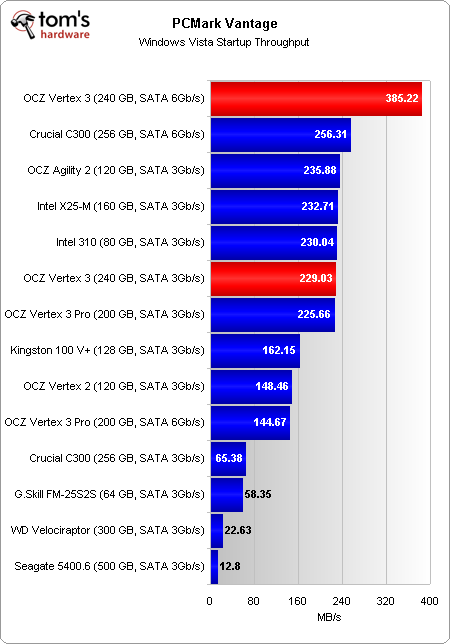OCZ's Vertex 3: Second-Generation SandForce For The Masses
Benchmark Results: PCMark Vantage Storage Test
PCMark Vantage comes as close as we get to approximating real-world performance using a synthetic benchmark. The Application Loading metric measures disk drive performance while loading Microsoft Word 2007, Adobe Photoshop CS2, Internet Explorer 7, and Outlook 2007.
This is just the beginning of the trend, but notice that both disk drives fall to the back of the line. Even Western Digital's VelociRaptor can't keep pace.
While PCMark Vantage is the closest thing to showing real-world performance, it has its own flaws. As in our Vertex 3 Pro coverage, we see about 5000 PCMark variance in the final score when we rerun the test. We noticed that the drive would either perform outstanding in Windows Defender or Application Loading, but never both. We have seen variances with PCMark in the past and this is well within those tolerances, but it is something we wanted to mention for those curious about our numbers. Furthermore, we were unable to get the C300 to finish a complete run, which is why we lack a overall HDD Suite score.
Using >99% streaming reads, Vertex 3 nearly hits the same speeds as the Vertex 3 Pro. However, this doesn't come anywhere near the drive's peak specs.
The video editing test is split more evenly between reads and writes. This time we see the Vertex 3 continuing to trail the Vertex 3 Pro. Crucial's C300 follow closely behind.
As we already mentioned, the Windows Defender benchmark shows a lot of variance when we start testing the C300, Vertex 3, and Vertex 3 Pro in a SATA 6Gb/s configuration.
The Windows Media Center test runs SD video playback, SD video streaming to an extender, and records an SD video concurrently, yielding an even split between reads and writes. This time we finally see the Vertex 3 punch through the bandwidth limitations of SATA 3Gb/s.
Get Tom's Hardware's best news and in-depth reviews, straight to your inbox.
SandForce drives typically do very well in read performance, and we see it here. Notice the progression from SandForce to Intel to older drives.
The photo import test is also mostly read-based, so it isn't a surprising to see the Vertex 3 fall behind. We should point out at this benchmark also shows quite a bit of variation.
OCZ tops the chart again. Remember that this is naturally almost all read-based.
Current page: Benchmark Results: PCMark Vantage Storage Test
Prev Page Benchmark Results: 4 KB And 512 KB Random Writes Next Page Benchmark Results: Power Consumption







